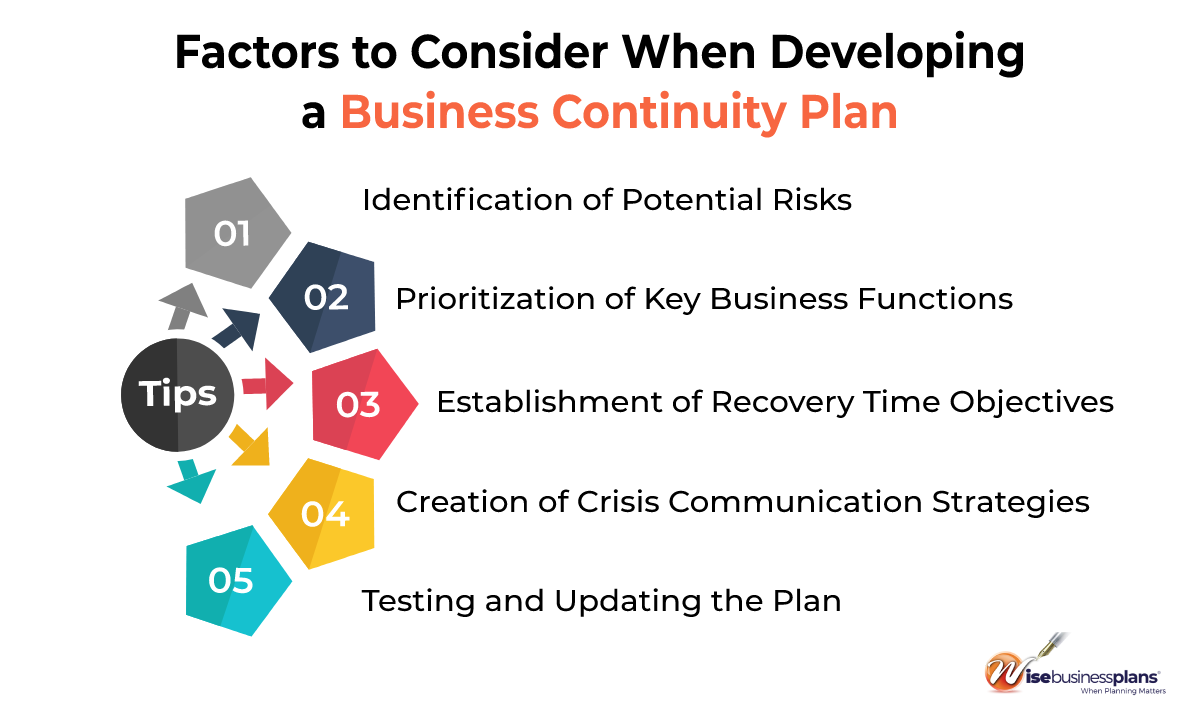What Is the Primary Goal of Business Continuity Planning?
Table of Contents
- What Is a Business Continuity Plan?
- What Is Business Continuity Management?
- Understanding Business Continuity Planning
- Why Business Continuity Planning is Important?
- What Is the Primary Goal of Business Continuity Planning?
- Understanding the Primary Goal of Business Continuity Planning
- Key Components of a Business Continuity Plan
- Factors to Consider When Developing a Business Continuity Plan
- The Role of Business Continuity Planning in Disaster Management
- Need consultancy in writing a business plan?
- Conclusion
- FAQ's
- Disruptions and unexpected events can have a significant impact on a business’s ability to operate effectively.
- Business continuity planning aims to minimize the impact of these events and ensure that critical business functions can continue.
- The primary goal of business continuity planning is to ensure that an organization can quickly recover from a disruption and continue its operations with minimal impact on customers, employees, and other stakeholders.
What Is a Business Continuity Plan?
Business continuity is the process of ensuring that critical business functions continue to operate during a crisis. A business continuity plan is a comprehensive plan that outlines how an organization will continue to operate during and after an unexpected event or crisis. The goal of a business continuity plan is to ensure that essential business processes can continue with minimal disruption.
What Is Business Continuity Management?
Business continuity management (BCM) is the process of identifying potential risks and developing strategies to ensure that critical business functions can continue in the event of an unexpected event or crisis. BCM involves developing a comprehensive plan that outlines the steps that need to be taken to minimize the impact of a disruption on an organization and ensure that it can quickly return to normal operations.
Understanding Business Continuity Planning
Business continuity planning (BCP) is a critical component of business continuity management (BCM). BCP is the process of creating and implementing a plan that outlines how an organization will continue its critical functions and operations in the event of a disaster or unexpected event. The BCP outlines the steps that need to be taken to minimize the impact of a disruption on the organization and ensure that it can quickly recover and resume normal operations. The plan typically includes detailed procedures for communication, emergency response, backup systems and data recovery, and continuity of operations. Regular testing and updating of the plan is essential to ensure its effectiveness.
Don’t wait for a disaster to strike – start implementing a business continuity plan (BCP) now to protect your business and ensure its survival in the face of unexpected events.
Why Business Continuity Planning is Important?
Without a business continuity plan, organizations risk losing critical data, losing access to essential systems, and even going out of business altogether. Disruptions can result in lost revenue, reputational damage, and legal or regulatory non-compliance. Business continuity planning can help organizations to prepare for and respond to disruptions, ensuring that they can continue to deliver products or services to customers, maintain the confidence of stakeholders, and remain competitive.
What Is the Primary Goal of Business Continuity Planning?
Business Continuity Planning (BCP) is a critical aspect of every organization. The primary goal of BCP is to ensure that essential business operations continue in the event of an unplanned disruption, such as a natural disaster, cyber-attack, or any other catastrophic event. In this article, we’ll dive deeper into the topic of Business Continuity Planning, its primary goal, and why it’s essential for every business.
Access our 14 free sample business plans now!
Understanding the Primary Goal of Business Continuity Planning
The primary goal of Business Continuity Planning is to enable an organization to continue providing its essential business functions during a disaster or any other unexpected event that threatens the organization’s operations. This goal aims to ensure that business operations can continue with minimal disruption and downtime, reducing the impact on the organization, its employees, and its customers.
Key Components of a Business Continuity Plan
A business continuity plan should include the following key components:
Risk Assessment
Identifying potential risks and assessing their likelihood and potential impact on the organization.
Business Impact Analysis
Identifying critical business functions and determining their priorities in the event of a disruption.
Emergency Response Plan
Outlining the procedures and protocols that need to be followed in the event of an emergency, including evacuation, communication, and first aid.
Data Backup and Recovery Plan
Outlining the procedures and protocols for backing up and recovering critical data and systems.
Communication Plan
Outlining the procedures and protocols for communicating with employees, customers, vendors, and other stakeholders in the event of a disruption.
Continuity of Operations Plan
Outlining the procedures and protocols for maintaining essential business functions and resuming normal operations as quickly as possible.
Benefits of Business Continuity Planning
Business Continuity Planning provides numerous benefits to an organization, such as:
Protection against Risks
One of the key benefits of BCP is protection against potential risks. By identifying potential risks and implementing strategies to mitigate them, an organization can safeguard its critical business functions from the impact of any unplanned event.
Minimization of Downtime
Another benefit of BCP is that it minimizes downtime. In the event of a disaster, a BCP enables an organization to quickly recover its essential business functions, thereby reducing the amount of time the organization remains inactive.
Maintenance of Customer Confidence
A well-developed BCP helps maintain customer confidence in an organization. Customers will have greater trust in an organization that can continue providing essential services even during a crisis, ensuring that the organization continues to generate revenue.
Preservation of the Company’s Reputation
In addition to customer confidence, a BCP helps preserve an organization’s reputation. By showing its stakeholders that it can quickly respond and recover from a disaster, an organization can protect its reputation and demonstrate its commitment to responsible business practices.
Factors to Consider When Developing a Business Continuity Plan
Several factors must be considered when developing a BCP. These include:
Identification of Potential Risks
The first step in developing a BCP is to identify potential risks that could disrupt essential business functions. Organizations should identify both internal and external risks and prioritize them based on their potential impact.
Prioritization of Key Business Functions
Once risks have been identified, organizations must prioritize their critical business functions. This ensures that they can focus on recovering those functions that are essential to the survival of the organization.
Establishment of Recovery Time Objectives (RTOs)
Recovery Time Objectives (RTOs) are critical in BCP as they establish the maximum time an organization has to recover its critical business functions. RTOs should be established based on the prioritization of business functions and the potential risks identified.
Creation of Crisis Communication Strategies
In the event of a disaster, effective communication is crucial in managing the situation. A BCP should include a crisis communication plan that outlines how the organization will communicate with its employees, customers, and stakeholders.
Testing and Updating the Plan
Once a BCP has been developed, it must be tested and updated regularly. Testing ensures that the plan is effective and can be implemented in the event of a disaster. Updating the plan ensures that it remains relevant and takes into account any changes in the organization’s operations or potential risks.
The Role of Business Continuity Planning in Disaster Management
BCP plays a critical role in disaster management by providing a framework for managing the impact of a disaster. The following are the four phases of disaster management and how BCP fits into each:
Mitigation
BCP helps mitigate the impact of a disaster by identifying potential risks and implementing strategies to minimize their impact on critical business functions.
Preparedness
Preparedness is crucial in disaster management, and BCP plays a critical role in ensuring that an organization is prepared to respond to a disaster. A well-developed BCP ensures that an organization can quickly respond to a disaster and recover its essential business functions.
Response
During the response phase, BCP provides a framework for managing the impact of the disaster on critical business functions. The plan outlines the steps to be taken to recover the functions, communicate with stakeholders, and manage the situation.
Recovery
The final phase of disaster management is recovery, where an organization must rebuild and restore its operations. BCP plays a critical role in ensuring that an organization can recover quickly and efficiently, minimizing the impact of the disaster on the organization, its employees, and its customers.
The Business Continuity Planning Process
The Business Continuity Planning (BCP) process involves several steps that must be followed to ensure a comprehensive plan is developed. These steps include:
Business Impact Analysis (BIA)
The first step in the BCP process is to conduct a Business Impact Analysis (BIA). This involves identifying critical business functions, assessing the impact of a disruption to those functions, and determining the recovery time objectives (RTO) for each function.
Risk Assessment
The second step in the BCP process is to conduct a risk assessment. This involves identifying potential threats to the organization, assessing the likelihood and impact of those threats, and determining appropriate mitigation strategies.
Business Continuity Strategy Development
Based on the BIA and risk assessment, the next step is to develop a business continuity strategy. This involves selecting the appropriate recovery options for each critical business function and determining the order in which those functions will be recovered.
Plan Development
Once the business continuity strategy has been developed, the next step is to create a comprehensive BCP. This should include detailed procedures for each critical business function, as well as instructions for activating the plan and coordinating the recovery effort.
Testing and Maintenance
The final step in the BCP process is to regularly test and maintain the plan. This involves conducting exercises and drills to validate the plan, identifying any gaps or areas for improvement, and updating the plan as necessary to ensure it remains current and effective.
By following these steps, organizations can ensure that they have a comprehensive and effective business continuity plan in place to minimize the impact of disruptions and ensure continuity of critical business operations.

Need consultancy in writing a business plan?
Hire business plan consultants now!
Conclusion
In conclusion, the primary goal of Business Continuity Planning is to ensure that an organization can continue providing its essential business functions during a disaster or any other unexpected event. By developing a BCP, organizations can protect themselves against potential risks, minimize downtime, maintain customer confidence, and preserve their reputation. BCP plays a critical role in disaster management, providing a framework for managing the impact of a disaster on an organization’s operations.
FAQ's
Here are some frequently asked questions (FAQs) about the primary goal of business continuity planning:
The primary goal of business continuity planning is to ensure that critical business functions can continue in the event of a disruption.
Business continuity planning is important because it helps organizations prepare for and respond to unexpected disruptions that could impact critical business operations.
Business continuity planning is focused on ensuring that critical business functions can continue in the event of a disruption, while disaster recovery is focused on recovering IT systems and infrastructure in the event of a disaster.
Business continuity planning is the responsibility of senior management and the business continuity team.
Business continuity plans should be reviewed and updated on a regular basis, typically at least once a year or whenever there are significant changes to the organization or its operations.


